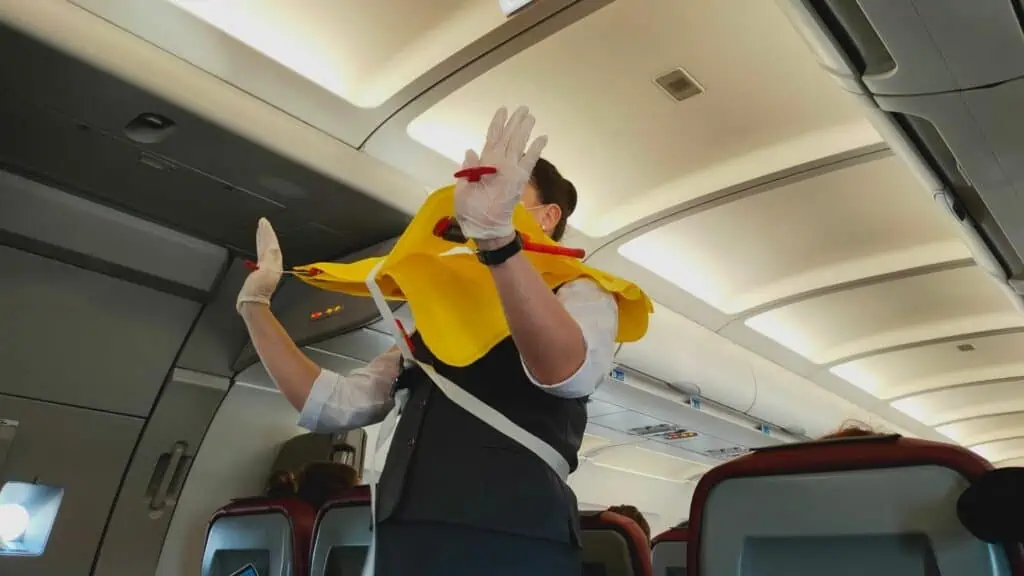There are a number of factors that determine how many flight attendants will be on a flight. These include legal requirements, the size of the aircraft and the level of service that an airline provides.
Many people might be surprised to hear that the primary responsibilities of flight attendants are the operation and safety of the aircraft – not to serve food and drinks.
They are certainly much more than flying waiters/waitresses.

The Quick Answer: The number of flight attendants on a plane varies. There could be just one on a small aircraft and up to 21 on a double-decker Airbus A380-800.
So let us look at the different things that influence the number of flight attendants there might be on a particular flight.
Contents
Safety Requirements
The bodies that govern aviation throughout the world, such as the Federal Aviation Administration (FAA) in the US and the Civil Aviation Authority (CAA) in the UK, set down minimum flight attendant numbers on a commercial flight. This is in order for an aircraft to be able to operate safely and to deal with passenger safety during emergency situations, to operate the emergency equipment, and assist in the event of an emergency evacuation.
These minimum numbers of cabin crew set by FAA regulations are generally linked to the seating capacity of the aircraft and are roughly one flight attendant for every 50 passengers.
Aviation law in the US states that the following are the minimum number:
| Seating Capacity | Minimum Flight Attendant Numbers |
|---|---|
| Less than 9 seats | A flight attendant is optional (on most light planes with 8 seats or less a flight attendant would be impractical as often a central aisle would not exist) |
| Between 9 and 19 seats | One flight attendant, if the maximum payload of the aircraft is more than 7500 pounds |
| Between 19 and 50 seats | One flight attendant |
| Between 51 and 100 seats | Two flight attendants |
| Between 101 and 150 seats | Three flight attendants |
| Over 150 seats | Three plus for each additional 50 seats there must be one additional flight attendant |
As an example, for an aircraft with 260 passenger seats, the minimum would be six flight attendants required with no maximum number.
This minimum number of flight attendants must be on board from the moment the first passenger boards in case of an emergency.
Aircraft size

Naturally, the larger an aircraft is the more passenger seats it will have and so the number of cabin crew members required to operate it will be higher too.
An Airbus A380-800 can carry up to 868 passengers in an all-economy configuration so using the rules specified above this means that the minimum number of flight attendants needed to safely operate the aircraft would be 18.
Here are a few examples for various types of common aircraft, including how many flight attendants on an Airbus a320:
| Aircraft Type | No of Flight Attendants |
|---|---|
| Boeing 737 | 4 to 6 |
| Boeing 777 | 13 to 16 |
| Boeing 787 Dreamliner | 10 to 17 |
| Airbus A320 | 4 to 6 |
| Airbus A380-800 | Up to 21 |
Airline service

Airlines that are noted for having very high levels of service such as Singapore Airlines or Emirates tend to have quite a high ratio of passengers to flight attendants. British Airways often have a high number of cabin crew too.
It should not be a surprise to hear that budget airlines would normally have fewer flight attendants than full-service airlines on the same type of aircraft.
In fact, in the airline industry, it is usual for most airlines are likely to have more crew members than the absolute minimum allowed.
First class/business class
If a flight includes a large section for first and business class then the number of flight attendants will likely be significantly higher as the greater level of service requires more cabin crew to supply it.
Economy class
Lower levels of service in an economy cabin clearly require fewer cabin crew so the ratio of passengers to crew will be lower. If a flight is in an all-economy configuration it will have fewer than if the same aircraft had a first-class, business-class and economy-class layout.

How many flight attendants are on an international flight and a domestic flight?
On short-haul flights, it would normally not make any difference how many cabin crew members there are whether the airplane is operating domestic or international flights.
It can make a difference if an international flight is a very long non-stop flight. These flights would normally have additional crew members on board (both flight crew and cabin crew) as the flight attendants are required to take breaks during the flight.
So, for example, a non-stop flight from the UK to Sydney, Australia takes over 19 hours so clearly it would be wrong for the crew to work 19 hours straight for the entire flight without any rest time. The crew numbers would not be double on these flights but there would normally be an additional 15-20% to allow adequate breaks.
There are crew quarters on some long-haul aircraft that include bunks so each crew member can get some sleep.
Flight crews would often include one or two pilots in addition to the standard two pilots in the flight crew too on very long flights.

I have been traveling around the world by air since the early 70s and living overseas too. I worked for British Airways for a number of years and I am also a private pilot. About Me



